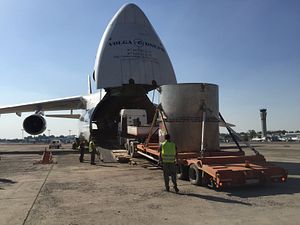Uzbekistan no longer has any highly enriched uranium (HEU) lying around. On September 28, the IAEA announced that on September 24 the last of Uzbekistan’s HEU — 5 kilograms (about 11 pounds) from a research reactor at the Radiation and Technological Complex in Tashkent — had been safely transported out of the country and transferred to the Mayak reprocessing facility in Russia.
The United States, Russia, and the International Atomic Energy Agency (IAEA) have been working since 2002 to return Russian-origin HEU located around the world to Russia. The Russian Research Reactor Fuel Return (RRRFR) program is just one of a successive number of initiatives and ad hoc projects between the U.S. and Russia regarding nuclear materials.
The U.S. Department of Energy’s National Nuclear Security Administration (DOE/NNSA), which manages U.S. involvement in the RRRFR program, noted in a press release that this is the eighth (and final) shipment of HEU out of Uzbekistan since 2004. DOE/NNSA Deputy Administrator Anne Harrington said in a press release that “[t]his shipment and our ongoing partnership with Russia and the International Atomic Energy Agency advance global efforts to secure, consolidate, and minimize the use of highly enriched uranium so it does not fall into the hands of terrorists.”
This particular shipment, the IAEA says, represents a milestone for the program as it was the “first removal operation of irradiated liquid HEU fuel.” DOE/NNSA called the removal “logistically challenging,” owing to the fact that it was the first transport of spent liquid HEU fuel by air. The RRRFR program, according to the IAEA’s numbers, has “facilitated the transfer of nearly 2,160 kilograms of former USSR-supplied HEU from 14 countries to Russia in 61 shipments.” Uzbekistan joins 10 other states in now being free of HEU fuel.
According to the Nuclear Threat Initiative (NTI), India’s 1974 nuclear test “spurred both the United States and the Soviet Union to launch programs in the 1970s to mitigate the threat of possible misuse of HEU from civilian installations.” Up to that point, nuclear weapon states had exported material and technology to more than 40 countries to set up LEU, and later HEU, reactors for research purposes. India’s test changed public perception and introduced worries that civilian-use nuclear materials could be repurposed by states or obtained and misused by terrorists.
The collapse of the Soviet Union only increased these worries as a number of newly independent states were left with materials they did not want and could not safely maintain. Kazakhstan, for example, was left hosting the world’s fourth largest stockpile of nuclear weapons. The country moved all 1,400 of them back to Russia by 1995 and has worked diligently as an advocate of non-proliferation since. Last year, HEU from Kazakhstan’s Alatau reactor was repatriated to Russia under the same program and, as will happen in Uzbekistan, the IAEA is working with Kazakhstan to switch the reactor to using LEU.
The U.S. and Russia have serious disagreements on a whole range of international issues, but while relations have deteriorated over Ukraine and Syria, with regard to global nuclear safety the two are still moving forward at a steady pace.

































